In the land where everything is bigger and better, the fishing is hotter, faster and vastly popular, even in unlikely locations.
There’s no doubt that in the USA, they’re mad-keen on their outdoors, especially fishing and hunting. It had been years since I’d fished there, so when I got the offer to go, I couldn’t say yes quickly enough. And to top it off, our trip was to coincide with ICAST (the biggest sportsfishing trade show in the world) and we were given VIP access.
Like so many other trips, this one started small, but then Shimano and Yamaha America jumped in on the act by inviting us on trips all over the place. Suddenly, we were planning some serious adventures and packing them into just a few weeks. You name it, we were doing it – taking an astronaut fishing, chasing snook, exploring the Everglades and even fishing the Gulf of Mexico. Looking at the itinerary, we’d be spending as much time travelling as we would fishing … go hard or stay home, I say!
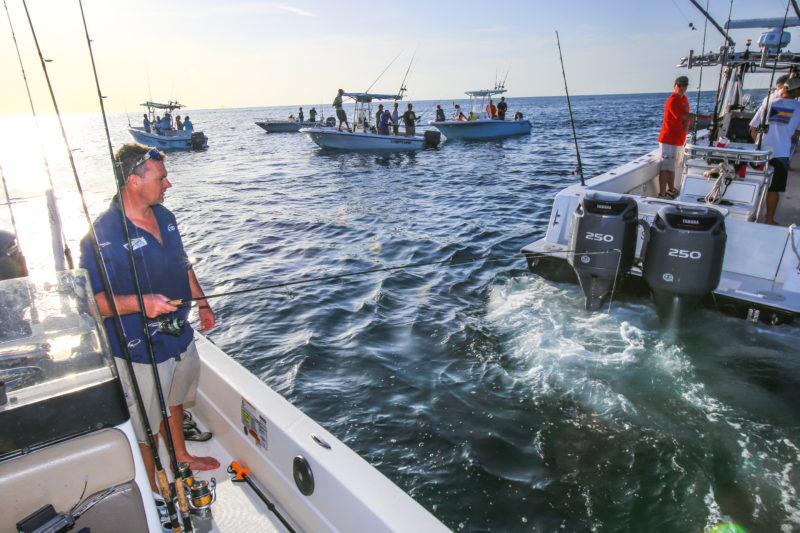
With such a tight schedule and so much to shoot, we had to organise a second cameraman and appointed the ever-helpful Mick Lyons as camera assistant.
Our first stop was ICAST in Orlando, Florida. When they say they do it bigger in the USA, they’re not joking – compared to Australian fishing shows, it’s huge! For a mad-keen fisho, it was like a kid in a candy shop and all I can say is that I’m glad I couldn’t buy anything.
From the trade show, we went straight to NASA at Cape Canaveral, Florida, to meet up with astronaut Jon McBride. As it happens, he had taken the first Aussie into space, with naval oceanographer Paul Scully-Powers aboard the shuttle Challenger in 1984.
Our job was to catch Jon a fish. It sounded easy, however they get some insane storms in Florida and, sure enough, we soon found ourselves dodging thunderstorms rather than fishing. Eventually, we managed to land a barracuda and, while it wasn’t quite what I had come halfway around the world for, we couldn’t wipe the smile off Jon’s face.
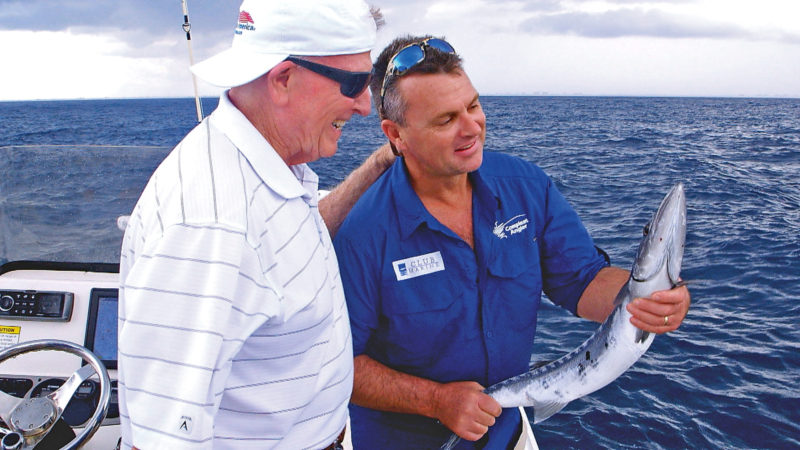
Jamie Glasner, our guide from Cocoa Beach’s Fin and Fly Charters, was in the same frame of mind as I was and, equipped with some good intel of an awesome snook bite down south, he suggested we relocate the next day. So, at an ungodly hour in the morning, we drove 300km on the wrong side of the road to meet Jamie at the beautiful Saint Lucie Inlet.
Chasing Snook
Snook are the USA’s answer to our barramundi. Not only do they look similar, they have very similar habits, favouring coastal and estuary environments and lurking in the mangroves, stands, or gutters, ready to ambush any prey that comes too close. Growing to as much as 25kg, they are as popular a sportsfish over there as barra are here. They’re targeted with very similar techniques using artificials, but livebaits are the key to the big fish. Interestingly, they do differ in their spawning habits. With no wet season to spur them on, snook school up around estuary mouths, where you’ll find big females … and it just so happened that our trip coincided with this aggregation.
Before we knew it, we had piled our gear into Jamie’s boat and were running down the inlet. In the US, everything is bigger and better … and nowhere is this truer than with boats. Tied up to the docks were some of the best and sexiest boats I have ever seen and, as we headed out to sea, I was gobsmacked by the endless procession of awesome sportsfishers.
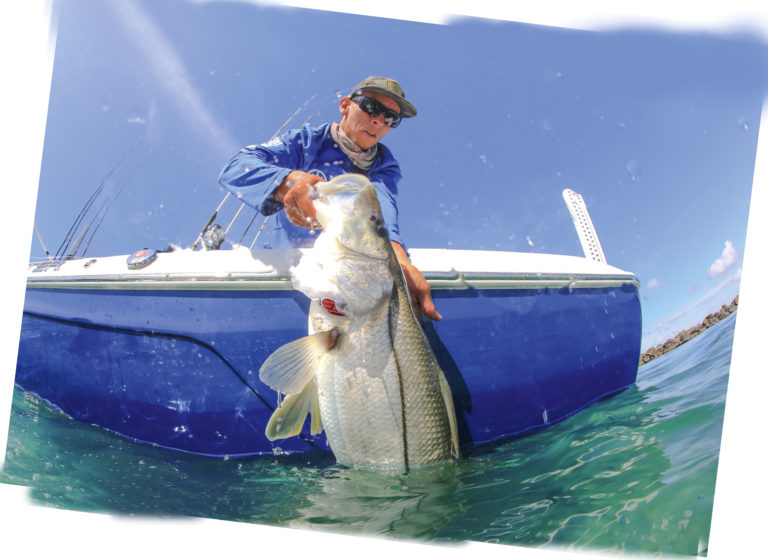
The key to catching big snook is to fish with livebait, so our first task was to fill the bait tank. Finding bait is easy – just join the rest of the fleet in the ‘parking lot’. Unlike Australia, where everyone would be screaming at you if you got within a hundred metres of them, the boats were so close that they actually nudged each other like dodgem cars. And not one bad word was said … mind you, half the skippers were packing a sidearm.
With the bait tank chockers with herring, we scooted off to the jetty to start fishing. This is where some confusion set in: for you and me, a jetty is a pier, but in the US it’s a rockwall. So, as we approached, I kept asking where we were fishing and Jamie kept pointing to the ‘jetty’ … but all I could see was a rockwall. Try as I might, I couldn’t, for the life of me, see the jetty he was pointing to. But, as we pulled up next to the rocks, I finally figured out what a jetty is in the USA …
Anchoring the boat in just a few metres of water on sand just off the rockwall, we wasted little time in pinning a couple of baits on circle hooks and pitching them out. With no weight, they drifted naturally along the edge of the rocks right where the snook were holding. At first, I couldn’t see them, but then Jamie pointed and I realised we were on top of a huge patch of snook. When Jamie hooked up, I was expecting a small fish … but when a 12-pounder broke the surface, I realised these were serious horses. Soon, he was busy backing that fish up with a 14-pounder, while I hadn’t even had a bite.
It’s really interesting to fish new grounds for a new species and it often takes a while to get into the groove. Initially, I struggled because I was thinking like barra and kept my bait tight in against the rocks, however the snook were moving right out into the open, preoccupied by the urge to spawn. Once I got this right in my head, they started biting.
At last, I connected and stayed tight. Unlike barra that race for the snags, snook are clean fighters that prefer to slug it out in the open. Years of experience told me it was a good fish, but the moment it breached the surface I was surprised – it was a stomper. Catching it was great, but even better was jumping in and swimming off with it. Then, to top it off, I realised there were snook just cruising around, seemingly unconcerned by my presence. To think this was all happening just off the beach, with boats going everywhere, was nothing short of spectacular.
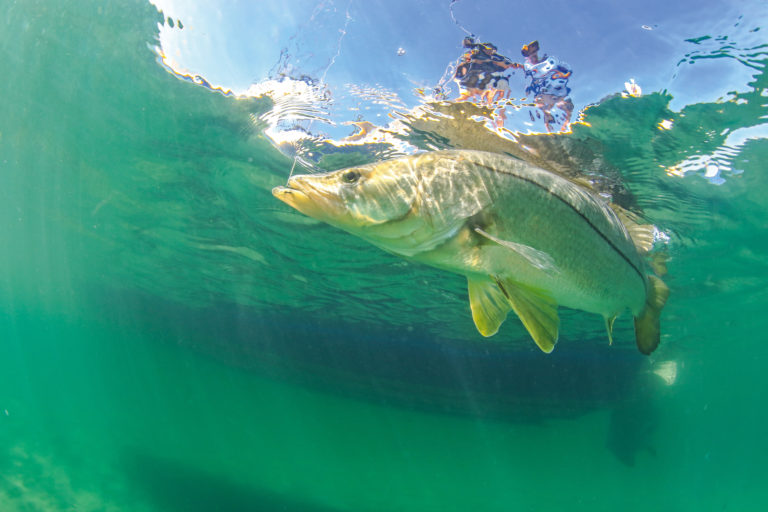
The Deep South
The following day, I was enjoying a beer in New Orleans on the way to our next fishing destination at Venice, located on the southern tip of Louisiana at the mouth of the mighty Mississippi River. This is one of the top fishing locations in the USA, with the Mississippi running almost the entire length of the country before pouring into the Gulf of Mexico. We hadn’t originally planned to fish there, but the guys from Shimano insisted this was the hot spot and set us up with husband-and-wife team Eric and Moe Newman, of Journey South Outfitters.
From the moment we met these guys, we were mates. They’re as passionate about fishing as I am and we wasted little time, charging out into the Gulf on their massive centre-console fishing boat. What immediately caught my eye were the number of oil rigs – they’re everywhere, all 3000 of them. In Australia, you’re not allowed within cooee of an oil rig, but in the USA, you can tie right up to them.
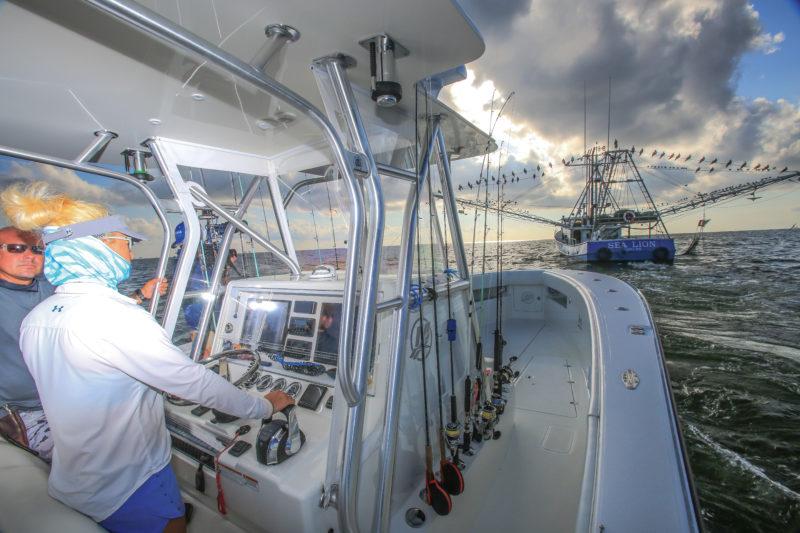
On our 40-mile run offshore, we pulled up behind some working shrimp boats to catch a few mack, tuna and cobia. The fish have learned to follow the boats for a free feed and, at times, even huge yellowfin join in. Just like in Florida, you can pull right up beside a working boat and not cop any abuse.
Tying up to our first oil rig, we threw a handful of burley and, in an instant, the water came alive. Throwing unweighted pilchards, we sight-fished to mangrove snapper, which are nearly identical to mangrove jacks and fight just as dirty. We got drilled countless times on the structure before landing a few fish for dinner.
We were already 40nm offshore, but Eric decided to run even farther to an even deeper rig, with the promise of some big amberjacks. Again, we pulled up next to a rig and sent a jig down on my Ballistix Stella outfit, but before it even got to the bottom, Moe was on. Cranking an amberjack up is not easy in shallow water and in a few hundred metres it’s tough work – I should add that Moe gets up before she goes fishing just to work out, so she is really fit and smashed the fish. Next drift, I was up and ready for action. The final drift worked and I found myself tied to a serious amberjack. They don’t fight quite as hard as kingies, but they don’t come easy, either, and when 20kg of PB amberjack appeared I was stoked … and realised why Shimano had been so keen to get us over there.
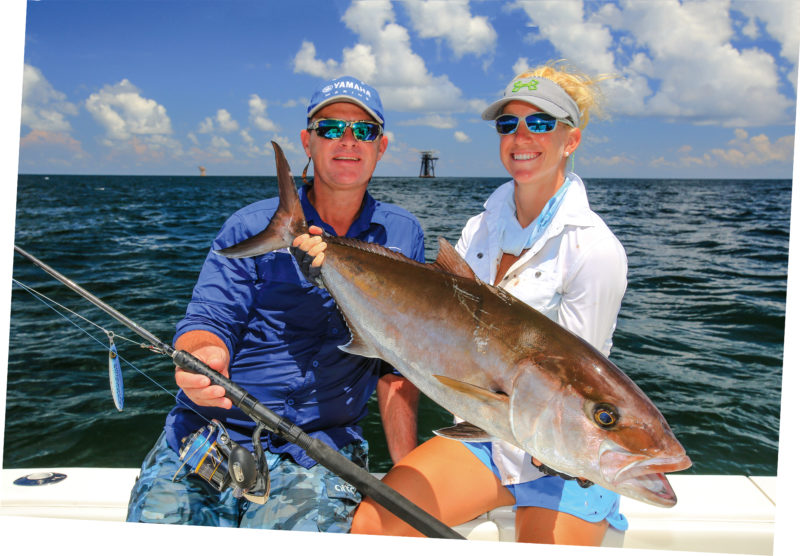
The Everglades
Our final stop was at the famous Everglades, at the southern end of Florida. Largely encompassed by the Everglades National Park, this unique environment offers some amazing fishing. The flats fishing around its lower reaches is world renowned, with a maze of mangrove stands and seagrass flats, split up by a string of channels, forming a shallow-water sportsfishing haven that is home to a staggering array of fish.
It’s really impressive that fishing is encouraged there – that’s right, fishing is encouraged in a marine park. That’s so different to Australia, where marine parks are designed to lock anglers out. Instead, in the USA, fishing is recognised as a major use of the area so, instead of banning anglers, they manage the fishery and the result is awesome.
Arriving at the boat ramp with Adrian Gray, of the International Game Fishing Association, to meet up with our guide, Steve Tejera of Knot Tight Fishing Charters, we were greeted by tarpon rolling around at the boat ramp while a manatee sat on the ramp inspecting the boats as they launched.
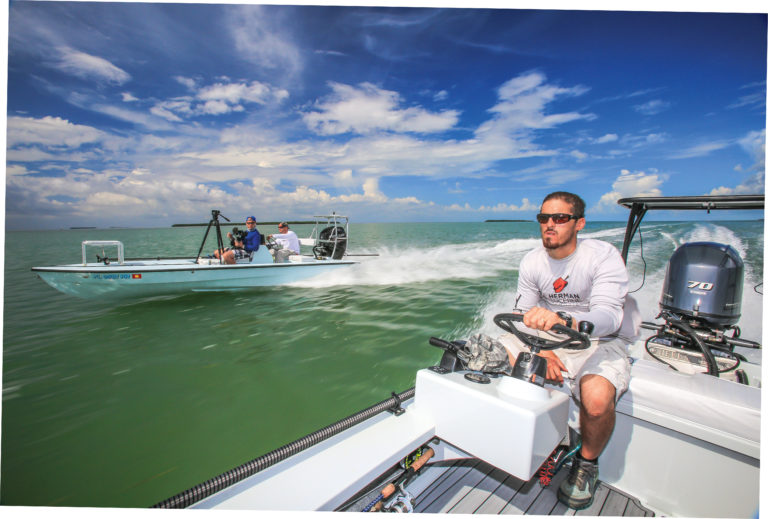
A few minutes later, we were scooting through water barely a foot deep aboard a carbonfibre/Kevlar Hell’s Bay Professional, which has to be one of the sexiest flats boats ever built. With the Yamaha jacked right up, we raced across ridiculously shallow water with ease. However, as much fun as it was to run around, we were there to fish.
Instead of pulling up in crystal-clear water, Steve searched out the dirtiest water he could find. Baitfish, like mullet, stir up the mud as they feed and predators, such as tarpon, redfish and snook, patrol the edges to ambush the bait. Spotting the predators was all but impossible without decent sunnies and I was very appreciative of my Costas.
We drifted along the edge of the dirty patch with Steve guiding the boat by pole. The moment there was a boil or shadow, I fired a cast at it. Using lightly weighted plastics, it was exciting and more like hunting than fishing, with the bite nothing short of electrifying.
I caught a number of snook but, having caught those monsters on the east coast, I really wanted a redfish. There’s nothing like it in Australia – the only fish that come close are jewfish, but that’s about it. I missed a couple and then pulled the hook on some more, before finally staying attached. This time, it was a red and I was stoked.
During the day we saw heaps of tarpon, a fish I desperately wanted to catch. They’re an early morning option, however, and we missed them because we had spent the prime fishing time filming segments for Fish’n With Mates. I wasn’t going home without one, though, so I talked my cameraman Brad Cone into returning for a quick session in the morning. This was a real issue, as we had to drive to Miami the following day to fly to England and then on to Ascension Island, so I am not sure if we were mad-keen or just mad.
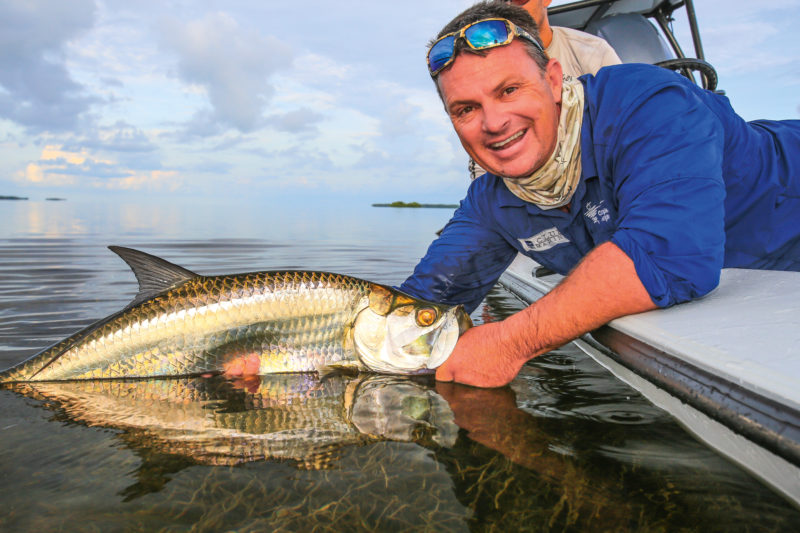
Arriving at first light, we had barely left the ramp before we spotted the telltale swirls of tarpon. Working along the edge of the mangroves, we flicked a lure as soon as we spotted one. It was very reactive fishing and the trick was to get the soft plastic to land a metre or so in front of the fish so as not to spook it, but so it could see it. That was the easy part … when it nailed it, staying attached proved much harder. First cast and I was in, then the tarpon jumped and the lure went flying. The camera crew loved it because it made great footage, but man, it was frustrating. Finally, I got one to the boat, only to have it jump off – bugger!
After several attempts, I spotted a flash of colour and fired my lure out in front – it was nailed immediately. The fish jumped and I stayed connected, then it powered off over the flat with me staying tight. At around 7kg, the fish wasn’t massive, but I was shaking as I slowly eased it in boatside. There were a few tense moments, and then we had it.
In Florida, since tarpon are such an important sportsfish and to maximise their survival rate, they are strictly catch-and-release and it’s illegal to remove them from the water. This is sensible fisheries management instead of just locking anglers out, as is often the case in Australia, especially when you see just how rich the fishing is and how much they care for their fishery. Despite the USA’s huge population, the fishing is awesome and is encouraged, with anglers recognised as true conservationists.




